Jonathan Walker's Blog
March 26, 2025
Recent Photographic Work
After completing my zine, Greenock/Gourock, mentioned in a previous post, I continued working on two other photo zines also relating to Greenock: Fifty and Greenock Central to Glasgow Central. I then decided to combine all three into a book, with the images from each zine as a separate section or chapter. The book is called Gourock, Greenock, Glasgow. Below are the intro texts for each zine (these have been slightly edited for the book version but not changed substantively), plus two images from each zine/book section.
Intro text for Greenock/Gourock:
I live in Gourock; I go shopping in Greenock. I walk around Gourock; I travel to Greenock by bus. Thiszine is about the differences and similarities between the two places.Gourock (current population 10,000) was originally a fishing village, then a seaside resort, and is nowa suburban residential area. It has a few shops, but no real economy. Rather, people travel from there towork, mainly by car. Some no doubt have jobs in Greenock, but others commute to Glasgow, which isabout an hour away on the motorway. I rent a room here, but the area where I live is mostly a zone ofowneroccupation,with detached or semidetachedhouses set back from the street by gardens. However,Gourock also has several areas of public housing, which are more densely inhabited and have more genericarchitecture.
Greenock (current population 41,000) is a larger regional centre, with local government buildings forInverclyde Council, a shopping mall, chain supermarkets, etc. But it is itself a satellite of Glasgow, and itsnineteenthcenturyprosperity depended on that proximity: that is, it is closer to the mouth of the ClydeEstuary than Glasgow, so it was easier and cheaper for some ships to unload sugar, tobacco and cottonthere rather than continue on to the larger city. The town was also a centre for shipbuilding and relatedindustries. Like many Atlantic ports and old industrial centres, Greenock’s fortunes have fallen, but itretains a busy freightcontainerterminal – and during the summer cruise ships use the town as a base forday trips. Greenock has greater visible extremes of wealth disparity than Gourock, with larger councilestates, including tower blocks, but also very grand individual houses, most of which seem to date back tothe town's heyday.
Suburbia is a place where dogs bark at solitary walkers. Being without a car and being alone are bothinherently suspicious states of being – taking photographs is even worse. If I could completely effacemyself, I would. I live a marginal existence, and I wanted these photos to express that: to depict not aninvasion of privacy, but a reluctance to trespass. A sense of distance and withdrawal – of tactfulness.
Intro text for Fifty:
I recently moved into a Housing Association flat in Greenock, a small post-industrialtown near Glasgow.When I counted up, I realised that this is the fiftieth place I’ve ever lived, which – since I’m in my mid-fifties– averages out at just over a year per location. The longest I’ve ever stayed in one place was in thehouse where I was born, for the first eight years of my life, followed by my aunt’s house in Liverpool,where I lived during my time in secondary school from 1981–8, and again for several months in 1998. The longest I’ve stayed anywhere as an adult was a rented flat in Sydney from 2006–11. I’m still surprisedto have ended up in Greenock, but I’m glad to have an apartment to myself after several years rentingrooms in shared accommodation. Because it’s a Housing Association flat, I can stay here as long as I want.So I’m trying to get to know my town: to relearn what it might mean to inhabit a place.Intro text for Greenock Central to Glasgow Central:
Train windows were the original screen technology. Long before the invention of cinema, they offered anendlessly scrolling spectacle to a seated passenger, who could not touch, enter or otherwise affect theworld beyond the glass. The photographs in this zine were taken on train journeys between GreenockCentral and Glasgow Central stations during February 2025. It might seem odd to think of these imagesin terms of spectacle, since that word normally implies something impressive or dramatic, and mostlywhat they show is the reverse of things. Back gardens, industrial estates, brownfield sites – along with theinfrastructure of the railway itself: bridges, power lines, and so on. But in many respects photographingfrom a train window is like photographing a cinema screen. On previous projects, I moved around apossible subject on foot, looking at it from different vantage points, and I often returned to the same sitemultiple times. Here, I couldn’t change my position, except insofar as the train itself carried me along. Atmost I could choose which side of the train I sat on, or which direction I faced. Or I could adjust myangle of view, for example with a zoom lens.
There were other constraints. I sometimes had less than a second to frame and photograph a subjectmoving past me at up to 90mph, and if I missed it, the only way to have another go was to retake thesame journey. In addition, the window glass, usually rather dirty, worked like a giant Vaseline filter, and,even worse, often held intrusive reflections from the train interior. When moving at fast speeds, there werealso far narrower tolerance limits for focus and shutter speed than normal. I’ve tried to minimise all theseeffects, but haven’t been able to eliminate them entirely. Under these circumstances, it was necessary toredefine what a ‘good’ photograph was: it became one that invoked the experience as much as one thatdescribed the subject. To put it another way, the constraints became part of the subject.
Two images from each zine/section:
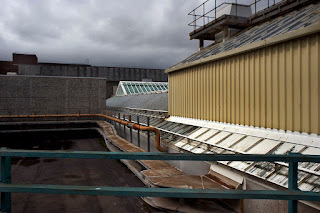
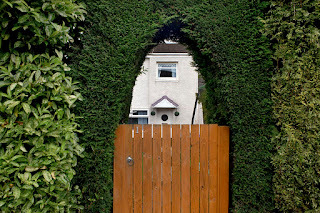
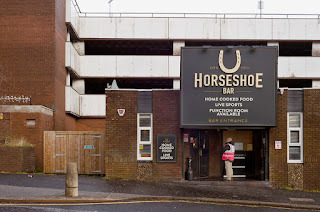
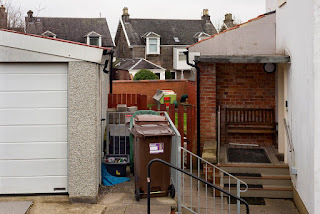
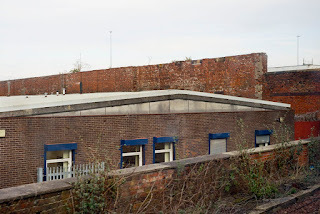
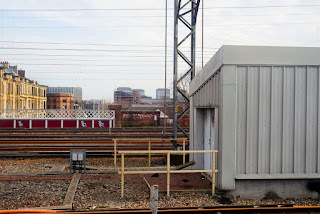
None of this work is currently available for purchase. I've just printed sample copies for myself and friends. Maybe someone else will publish it in future, or maybe not – more likely the latter, given the economics of photography publishing. I may take some of the sample copies to a local zine fair or two. But it was worth doing I think, irrespective of the outcome. Anyway, that's enough photography for the foreseeable future. Back to writing!
July 31, 2024
Glasgow Zine Library

Glasgow Zine Library in Govanhill is a fantastic community resource. They have thousands of zines by local creators in their archives – including these four by me!
Aldo and Aldous
24 pages, 16 colour photographs
My friends Harry and Ieva live with their young son Aldous and their two cats Clyde and Felix in a large house, which was built in the 1970s by two Italian migrants to Scotland named Aldo and Raffaella, who lived here together and raised a family. These photographs are about the encounter between Aldo and Aldous: two people who never met, but Aldous is discovering the world in a home still shaped by the love of Aldo and Raffaella.
Glasgow Anonymous
36 pages, 22 colour photographs
The photographs in this booklet depict locations where Cocaine Anonymous meetings take place in Glasgow. These meetings are not just made up of anonymous individuals; they also take place in anonymous spaces: borrowed rooms in church halls, community centres, or hospitals. Such buildings don’t draw attention to themselves; they sit within the broader landscape of the city. But they’re still visible, if you’re paying attention.
Greenock/Gourock
36 pages, 30 colour photographs
I live in Gourock; I go shopping in Greenock. I walk around Gourock; I travel to Greenock by bus. This zine is about the differences and similarities between the two places.
Suburbia is a place where dogs bark at solitary walkers. Being without a car and being alone are both inherently suspicious states of being – taking photographs is even worse. If I could completely efface myself, I would. I live a marginal existence, and I wanted these photos to express that: to depict not a to depict not an invasion of privacy, but a reluctance to trespass. A sense of distance and withdrawal – of tactfulness.
A Zone
32 pages, 37 colour photographs
A Zone is a photographic survey of the neighbourhood where I lived from 2018–21 – close to Glasgow city centre, in the shadow of the Kingston Bridge and M8 flyover.Not a neighbourhood then: a zone. Neglected by planners, shoppers and tourists alike, it offers a sample of all the kinds of activities we usually ignore in the modern city.
July 26, 2024
Greenock/Gourock
I've just finished a new photo zine, called Greenock/Gourock. It contains 30 images, 15 from each of the two locations in the title, in juxtaposed pairs. Here's the introductory text, and a few image pairs:
I live in Gourock; I go shopping in Greenock. I walk around Gourock; I travel to Greenock by bus. Thiszine is about the differences and similarities between the two places.Gourock (current population 10,000) was originally a fishing village, then a seaside resort, and isnow a suburban residential area. It has a few shops, but no real economy. Rather, people travel from thereto work, mainly by car. Some no doubt have jobs in Greenock, but others commute to Glasgow, which isabout an hour away on the motorway. I rent a room here, but the area where I live is mostly a zone ofowner-occupation, with detached or semi-detached houses set back from the street by gardens. However,Gourock also has several areas of public housing, which are more densely inhabited and have moregeneric architecture.
Greenock (current population 41,000) is a larger regional centre, with local government buildings forInverclyde Council, a shopping mall, chain supermarkets, etc. But it is itself a satellite of Glasgow, and itsnineteenth-century prosperity depended on that proximity: that is, it is closer to the mouth of the ClydeEstuary than Glasgow, so it was easier and cheaper for some ships to unload sugar, tobacco and cottonthere rather than continue on to the larger city. The town was also a centre for shipbuilding and relatedindustries. Greenock still has greater visible extremes of wealth disparity than Gourock, with largercouncil estates, including tower blocks, but also very grand individual houses, most of which seem to dateback to the town's heyday. Like many Atlantic ports and old industrial centres, Greenock's fortunes havefallen, but it retains a busy freight-container terminal – and during the summer cruise ships use the townas a base for day trips.
Suburbia is a place where dogs bark at solitary walkers. Being without a car and being alone are bothinherently suspicious states of being – taking photographs is even worse. If I could completely effacemyself, I would. I live a marginal existence, and I wanted these photos to express that: to depict not aninvasion of privacy, but a reluctance to trespass. A sense of distance and withdrawal – of tactfulness.
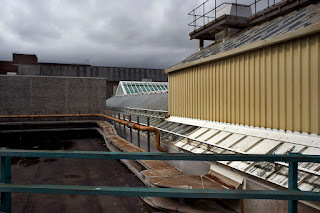
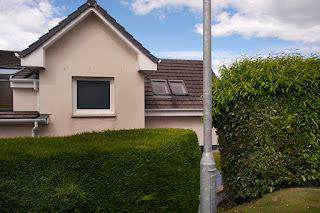
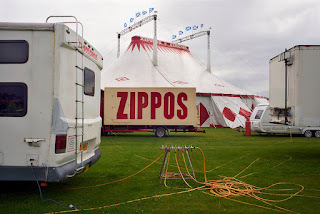
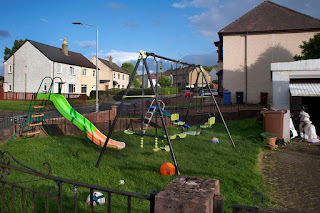
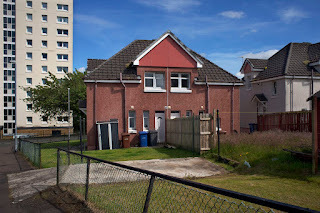
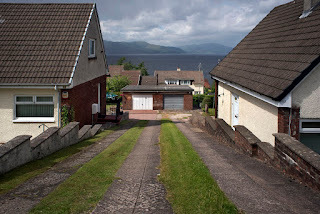
June 6, 2024
Review in Snack magazine
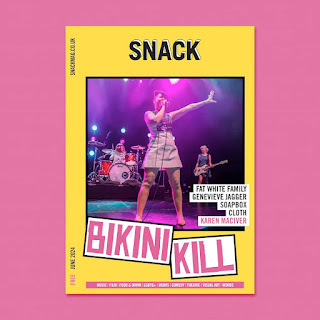
Nice review of Push Process by Charlotte Haley in this month's Snack magazine, which you'll find online and around Glasgow:
The book encourages us to pay attention: thedescriptions are detailed and hyper-focused, thephotography of Venice is layered and intricate,and the accompanying captions raise ideas thatany reader, novice or experienced photographer,can appreciate. ...
Like his photography, Walker’s writing iscontemplative, pairing pithy observations ... with highly specificphotography vocab and snippets of Italian.These specialist details rarely make the reader feelalienated, however: we become tourists in Venice,acquainted with Richard’s artsy friends Merlo andLars, catching soundbites and glimpses of meaningin a way that is clandestine, conspiratorial.
The subtle manipulation of perspective is whatreally makes this book shine, as we zoom in andout of Richard’s life like the focus on a camera lens ...
May 23, 2024
Review in The Scotsman
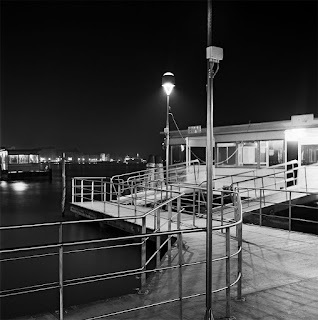
Great review for my novel Push Process in The Scotsman today by Robert Cox:
I have long been a fan of works of literature such as, say, Steven Hall’s The Raw Shark Texts, which experiment not just with the way a novel can be written, but also with its physical format. In Push Process, Walker not only weaves atmospheric and often somewhat enigmatic black and white photos of Venice throughout the text of his story about a history postgrad who falls in love with photography, he also includes a selection of some 48 images at the end, all his own. .... [The book's treats include] not just the never-less-than-fascinating discussions about photography and art, but also a genuine sense of being transported – by both words and images – to an atmospheric world of fully-realised characters for whom these questions are not merely of academic interest, but the stuff of life itself.
May 20, 2024
Two Videos
Just a quick reminder of two videos I did. The first is an introduction to the photosequence included in Push Process, my novel from Ortac Press.
The other is an introduction to Five Wounds, my first novel, which was originally published by Allen & Unwin, but is now available in a revised second edition.
May 13, 2024
A Zone
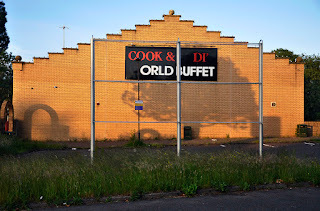
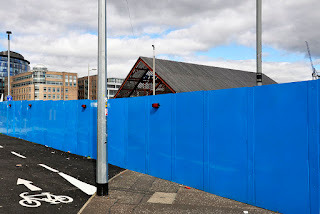

I have just self-published my zine A Zone, which is a photographic survey of the neighbourhood where I lived from 2018–21 – close to Glasgow city centre, in the shadow of the Kingston Bridge and M8 flyover. Everywhere pictured can be reached on foot within forty-five minutes from my old flat, and the photographs were taken from March to October 2020.
This area includes a wide variety of different sites: the various tributaries and slip roads of the M8 and M74; the ‘leisure complex’ of Springfield Quay arranged around an enormous car park; budget hotels; several retail or industrial parks; brownfield areas and construction sites; small offices for businesses of the sort that don’t need or attract walk-in customers; a couple of car dealerships; a homeless shelter in a nineteenth-century building that used to be a public library; takeaway restaurants; and so on.
Not a neighbourhood then: a zone.
The zine is 32 pages, full colour, on coated, heavy paper, £6.50/$9 plus P+P. Available from the link below.
May 6, 2024
A Couple of Reviews
A nice write-up for Push Process at the well-known Vertigo blog, dedicated to novels with embedded photographs.
And a positive review at 10 Million Hardbacks:
Just as a photograph compels the viewer to look at something afresh, a new perspective on the familiar, this unique work offers the reader another way to frame the magical city of Venice.
April 22, 2024
Another Extract From Push Process
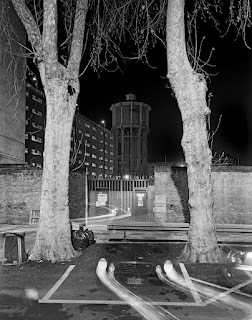
Arbus said: there’s what you want people to know about you, and what you can’t help people knowing. That’s what a portrait’s about. I say: there’s the thing I want to photograph, and all the things I can’t avoid photographing. I try to see everything in the frame – the grid on the viewfinder, square by square. But it’s impossible. And that’s what the picture’s about.
This is a seventeen-minute exposure. The car on the right is there for the first eight. The driver changes a baby’s nappy on the hood; he walks over, puts it in the rubbish bin on the left; returns to his car, drives away. All invisible, below the camera’s threshold of attention.
About the same time the first car leaves, the Mercedes in the middle backs into the frame. The driver gets out and says, Am I spoiling your photograph? Anzi. You’re doing something to it, but you’re definitely not spoiling it.
All that’s invisible too, and both cars are half there. By which I mean, they’re each there for half the exposure. What the photograph doesn’t register is their direction. Time’s a vector, but it runs both ways. Meets in the middle, and bleeds out both ends.
A third car in the background. Not visible at all, only a parabolic slash through the gates, which open electronically for a minute, then hum shut.
All these things exist in the gap that opens up between the camera’s attention and my perception. It’s always there, that gap. What photography’s for: to explore it, to articulate it as precisely as possible. The longer the exposure lasts, the wider it grows.
April 15, 2024
Photographic Inspirations: Atget's Seven Albums by Molly Nesbit
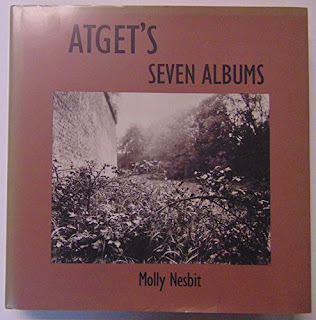
Eugène Atget (1857–1927) is the earliest of the photographic influences for Push Process, both in the sense of his place within photographic history and in the sense that my protagonist is first inspired to pick up a camera by Walter Benjamin’s famous aphorism: Not for nothing have Atget’s photographs been likened to the scene of a crime. But is not every square inch of our cities the scene of a crime? Every passer-by a culprit? I’m discussing him last because he never published a photobook, and his reputation is largely posthumous, in large part due to the efforts of the photographer Berenice Abbott, who acquired half of Atget’s archive of glass-plate negatives after his death.
I recently acquired a seminal work on Atget’s professional practice: Molly Nesbit’s Atget’s Seven Albums, published in 1992 by Yale University Press. What follows is a review/discussion of Nesbit's book, and some thoughts inspired by it.
What did Atget photograph? The historical and monumental traces of French and Parisian culture, with priority given to collective and anonymous achievements; also, a great deal of contemporary economic activity, and the culture associated with it (as we'll see below, this might include shop fronts, kiosks and so on, or the dwelling places and places of work for specific categories of worker); also some rural landscapes and natural phenomena (e.g. trees), the last category because of their assumed interest for artists. Much of the historical subject matter was grouped together in the contemporary imagination under the heading of 'Old Paris'. Museums and libraries were interested in records of Old Paris; so were antiquarians and amateur historians. Some of the economic activity Atget photographed also fell within this field: old shop signs, for example, or traditional, itinerant street traders. But even within this larger field, Atget's was a selective vision. Waldemar George noted in 1930 that he 'disdains panoramic views, grand syntheses, and synoptic tableaus' (quoted in Nesbit, 18), and Nesbit expands on this:
Atget's documents put forward a popular Paris, without the high life, without the reveries of an ancien régime, without the bourgeoisie. His Paris was a mass of common detail. ... the small shopkeeper and the worker on the street are given pride of place. (5, 6)
Encountering Atget’s archive unmediated is however a dispiriting experience. For example the MOMA collection (this is where the Abbott material is now held) is available online, and its contents are displayed in strictly chronological order on the MOMA website, beginning roughly in 1898 – Atget was a late starter as a photographer, after previous careers as a merchant seaman and an actor. If this collection feels unedited, containing images of highly variable quality, that’s because it’s really equivalent to looking at Atget’s contact sheets. All the images are in fact literally contact prints: Atget used a large-format 8x10-inch camera and didn’t enlarge any of his images, but instead created them using printing-out paper exposed by sunlight directly through the negative. But it should also be noted that reviewing the MOMA archive is not like looking at, for example, Robert Frank’s 35mm contact sheets, some of which you can find in Looking In: Robert Frank’s The Americans. Atget’s large-format camera didn’t allow for the kind of loose, casual experimentation in sequence through multiple exposures that rolls of 35mm film do. And although there are in fact numerous instances of hm taking multiple exposures of the same subject from different angles, or returning to the same spot on different occasions (sometimes years apart), his method was not to work through successive exposures towards the perfect crystallisation of a scene; still less was he in search of a decisive moment in which unstable, fleeting elements were in balance.
Atget was surely aware that some of his plates were more effective pictorial statements than others, but their primary purpose was to be of use to his customers. In other words, while some of them were more successful than others as photographs, few of them were treated as failures by Atget or discarded, because the subjects were more important than his images of them. And so long as they pointed effectively towards those subjects, they were adequate. When presenting prints to potential customers, Atget grouped them in themed albums, but these were not permanent compilations, and were akin to a catalogue, updated regularly. It’s not clear to me if one of the principles of these updates was to supplant inferior views of particular subjects with later, improved iterations, but even if Atget sometimes did this, he didn’t do it systematically.
Atget’s influence has therefore mainly been via selections of his work edited posthumously by others according to their own interpretations of his significance – and written commentary on his work was crucial from the start for determining its wider reception. In the first instance, this meant the book produced by Abbott in 1930: Atget: Photographe de Paris, with (in its French and English editions) an introduction by Pierre MacOrlan. Benjamin’s remarks on Atget, along with some similarly influential commentary by Walker Evans, were based on this book. By contrast, I primarily encountered Atget through the Phaidon 55 on him, published in 2001, edited by and with commentary from Gerry Badger.
All of Atget’s editors were in fact doing something similar to what his original customers did during his lifetime: putting together their own collections of his work according to their own predilections. These customers included artists – he famously described his practice as producing ‘documents for artists’ – illustrators, set designers, craftsmen, builders, architects, antiquarians, and above all several institutional libraries in Paris (also occasionally the V&A in London). For both Atget and his clients, his photographs:
were meant to refer beyond themselves, to be taken up repeatedly, to have several futures, and to exist as a point of detail on the way to one of them. They were meant to be incomplete. (35)
Most of his customers acquired multiple prints, and many of the libraries he sold to bought several hundred over the course of his career, which he or they might bind into albums, though not necessarily labelled with his name; and libraries might also mix his photographs with images on related subjects by others.
Nesbit's book is therefore of particular interest because the title refers to bound collections of images arranged by Atget, six of which he sold as integral albums to the Bibliothèque Nationale, where they were entered in the catalogue under his name as author and editor. Nesbit presents all the images from these albums in their original order, along with a seventh album that Atget also prepared, but failed to sell, and she analyses their contents within Atget’s larger practice and body of work. In doing so, she is concerned with an apparent contradiction: Atget’s description of his work as providing ‘documents for artists’, together with his disclaimer to Man Ray when the Surrealists wanted to use examples of his work as illustrations of the way unconscious energies animated the everyday: ‘Don’t put my name on it. These are simply documents I make.’ In fact, in other contexts Atget was quite happy to receive a named credit when his images were published as illustrations (as they often were), not least because that might increase his future sales, so one assumes he was specifically dubious about being associated with the Surrealists. In any case, how are we to square this with the description on his business card of ‘Author-Editor’ (the latter word can mean publisher as well as editor in French)? Nesbit sets out to explain precisely what it meant for Atget to create documents as an author and publisher: that is, she considers these terms in their contemporary cultural and legal contexts.
Atget's Seven Albums is clearly based on years of exhaustive research into the photographer’s papers and images, along with supporting investigations in French records and archives. Nesbit is insistent throughout that the key to understanding Atget is not to be found in treating him as an artist, which was not a synonym for author. He did not see himself as an artist, and nor did any of his customers. And that fact does not diminish or belittle his very real achievements.
This insistence has a wider significance for me. I am a photographer, and I prefer the work of other photographers. I mean that I am suspicious of those who situate themselves as artists first and photographers second. To give some specific examples: I prefer Gabriele Basilico to Thomas Struth; Robert Adams to Ed Ruscha; Atget to the Bechers. The primary orientation of photography should be towards the world, not the art market. I don’t need the word ‘artist’ to justify or dignify my work as a photographer, and Atget is the patron saint of this attitude. (This is about the primary orientation of the work: it doesn’t preclude making money from it or showing it in galleries, though I think it does preclude selling NFTs.)
In several cases, Nesbit is able to demonstrate how specific clients of Atget used particular images as references for their paintings and illustrations. She’s also able to show how images were used as illustrations in their own right in published works by others (with or without credit to Atget, though even with credit the photographs are never treated as anything other than transparent depictions of their subjects). However, the primary interest of Nesbit’s book is in presenting a selection of Atget’s work in terms dictated by the man himself, intended for posterity. The titular seven albums represent only a small fragment of the work Atget created, and his choice to present them as integral collections was dictated partly by opportunity, but they nonetheless show his creative intelligence at work as an editor of his own work.
The albums were all created in the years immediately preceding the First World War (the last was actually edited and presented to the library during the War, but the images were taken in 1913). They are on the following subjects:
Art in Old Paris [L’Art dans le Vieux Paris]
Parisian Interiors / Early Twentieth Century / Artistic / Picturesque & Bourgeois [Intérieurs Parisiens Debut du XXe Siècle Artistiques Pittoresques & Bourgeois]
Vehicles in Paris [La Voiture à Paris]
Trades, shops and shop displays of Paris [Métiers, boutiques et étalages de Paris]
Signboards and old shops of Paris [Enseignes et vieilles boutiques de Paris]
Inhabitants of the Zone [Zoniers]
Fortifications of Paris [Fortifications de Paris]

Art in Old Paris: The first album is the least successful, in every respect, but it is the most fully worked up as an object. It was prepared on Atget's instructions by a printer as a maquette with typeset captions, since Atget hoped to have it published as a book. Nesbit explains the likely reasons why he failed:
L'Art dans le Vieux Paris provided evidence, concrete evidence of Atget's defects, evidence of how habitually he had come to fidget within the regulation forms of the document, angling his perspectives more than necessary, not always aiming for perfect symmetry, making heavy contrast and uneven lighting his trademarks, allowing traces of later historical time to appear. Repeatedly we see doors left open, signs posted, horse manure in the streets.
Atget lost respectability with the Vieux Parisiens because of these kinds of details. He had not distinguished sufficiently between past achievement and modern debasement. No condemnation of the modern signboard, for instance, was made in the captions, no reference to the crashing incomprehension of the modern bourgeois culture that would sacrifice its past in the name of progress and profit. No effort to suppress or retouch the details of common life like carts and brooms and invocations to wipe one's feet please before climbing the stairs. (110)
Indeed, when Atget’s images were used as illustrations in books by others on Old Paris, Nesbit shows how they were retouched and/or cropped to exclude the details she singles out here (people, carts, etc.).
His captions for this maquette were far more detailed than usual, and even offer some anodyne aesthetic judgements ('remarkable', 'very beautiful'), but they were mostly cribbed from a guidebook: Nesbit also shows that they were sometimes erroneous, which would have been fatal for the book’s reception with an antiquarian audience.
‘Art’ in this album is really the work of craftsmen: that is, the decorative arts and architecture, not painting, although the album includes depictions of sculpture. But it feels like a pretty random compendium of these historical traces, with a little of everything but no systematic account of anything, and it doesn’t really play to Atget’s strengths. Even though this maquette was neither published nor acquired by the Bibliothèque Nationale, that institution signalled it would be receptive to other work presented in a similar format, which Atget duly provided.
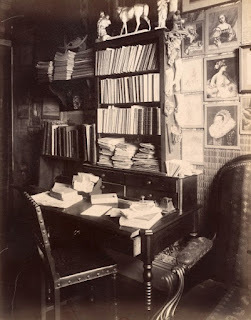
Parisian Interiors / Early Twentieth Century / Artistic / Picturesque & Bourgeois: Atget's work is sometimes compared to Louis Aragon’s Paris Peasant, which I discussed in a previous post, but there’s a lot of crossover with Walter Benjamin’s The Arcades Project as well. For example, Benjamin discusses the bourgeois interior, of the sort depicted in this album, which is about the relationship between culture and economy. These are unusual images for Atget, for whom negotiating access to interiors was no doubt extra work, which would have necessitated ingratiating himself with the occupants, and again the survey is less systematic than the title implies. For example, Atget’s own home appears three times, attributed each time to a different fictional occupant and occupation. In the first instance, he is ‘un’artiste dramatique’: this is not in fact a lie, since 'actor' remained his official occupation for several years after he began his photographic practice, and he continued in this line of work until c. 1910. In its last phase, his acting work seems to have consisted primarily of recitations of plays for working-class audiences attending night-school classes.
Nesbit contends that this album demonstrates Atget’s class consciousness by ironically juxtaposing interiors from wealthy occupants with more modest ones, but to me viewing these a century after the images were taken the similarity of the décor is more striking: that is, the more modest interiors seem to aspire to the same aesthetic as the wealthier ones. All the rooms are very cluttered; many have framed prints on the walls.
I know Atget primarily used a wide-angle lens, but I don’t know how wide: my guess would be a 180mm (roughly equal to a 28mm on a 35mm camera). In any case, while this worked fine for external views of architecture, where one usually had the option of taking a step backwards, it wasn’t quite wide enough for some of these views, which sometimes feel a little cramped or awkwardly cropped. I also don’t know if he used flash, but my guess would be no on the basis of the lighting patterns.
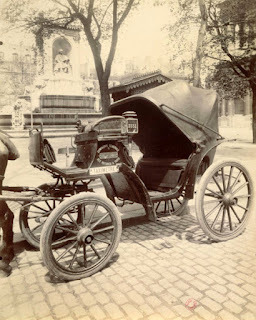
Vehicles in Paris: this is an almost comically matter-of-fact survey of carts, carriages and trams, with all the images framed fairly tightly (that is, although there are background details, here they don’t interact in an interesting way with the ostensible subjects). There are no motor cars: these occasionally appear in other Atget images, but, with the possible exception of the trams, everything here is horse-drawn – though the horses themselves are often cropped or absent, since Atget had to photograph stationary examples, so it was more convenient if they were parked. The effect is a little like one of Ed Ruscha’s books of gas stations or parking lots, though Atget's subjects feel closer to the world of the craftsman, simply because most of the vehicles are made of wood. And of course Atget’s intention was quite different to Ruscha's: not to illustrate the idea of taxonomy, but actually to be taxonomic. Ruscha is purposefully useless: Atget always intends to be useful. I wonder for whom these images might still be useful? Set designers for historical dramas perhaps – Atget’s original customers also included such people, though probably not in the case of this album, since they would not have needed to re-create contemporary vehicles.
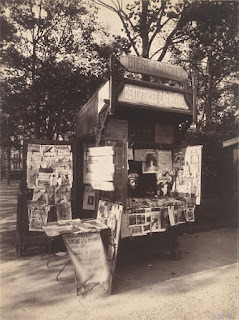
Trades, shops and shop displays of Paris: As Nesbit points out, the images here are mainly of shop displays, with only a couple of interiors. Some of Atget’s most famous images depict shop windows and mannequins, but most of those date from the 1920s. These earlier examples are not artful displays in department stores, which are in fact deliberately excluded. Rather, this album depicts open-air displays, often on tables set up on the pavement in front of shops, or market stalls, many selling food (vegetables, fish). Similarly, there are also plenty of kiosks (for newspapers or flowers). In other words, the featured businesses mostly sell to customers walking past on the street, and they form part of the life of the street. Their goods are not encountered as spectacle, separated from viewers behind glass, but are experienced with other senses besides sight: smell and touch.
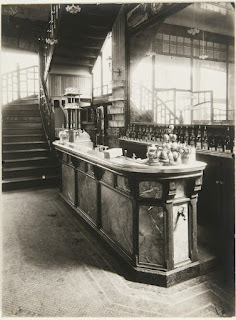
Admittedly not everything here fits this pattern. The album also includes a few cabaret or brasserie facades, along with one brothel entrance, and a few interiors: of two different wine merchants, a potter, a bookbinder – and Atget’s own desk advertised as the place of work of a photographer. The inclusion of this last means it’s not fanciful to suggest that Atget identified his own work with the other economic activities depicted here. Certainly he also mainly worked in the street (MacOrlan: 'Atget was a man of the street, an artisan poet of the Paris crossroads').
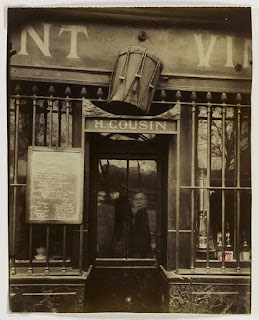
Signboards and old shops of Paris: This is back in Old Paris territory, since many of the shop signs and metal grills shown here were historical (or certainly the names were; many of the signs were likely nineteenth century). But the treatment here is more successful than the first album, even if quite modest in scope and ambition (Nesbit has more interesting things to say about this album than I have space to summarise here).
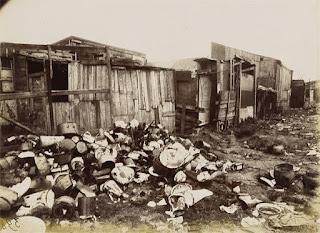
Inhabitants of the Zone: The last two albums are the most interesting. The ‘Zone’ was an area outside the city walls of Paris where permanent structures were forbidden. Originally this prohibition was for the purposes of military defence: I imagine to leave clean fields of fire beyond the city’s outlying fortifications. The disastrous outcome of the Franco–Prussian War of 1870–1, during which Paris had been occupied, had revealed the obsolescence of this provision, but it hadn’t been repealed. So although the Zone had many inhabitants, they lived in nominally temporary accommodation.
This album concentrates on a particular group of Zoniers: the chiffoniers, or rag-pickers, whose activities were an integral part of the daily rubbish disposal and recycling process in Paris, where they had the right to collect and sort certain kinds of material (glass, metal, cloth, etc.). Atget’s photographs show the caravans and shacks where they both lived and worked, along with several depots or intermediate businesses where the sorted rubbish was collected before being fed back into the city’s economy. He doesn’t however provide any detailed captions for any of this, so we are reliant on Nesbit’s commentary for making sense of what we see, and more broadly for understanding the place of the chiffoniers within French culture and the Parisian economy.
The ragpickers themselves appear intermittently, usually paused from their work, sometimes a little blurred by the long exposure: that is, Atget doesn’t attempt to depict their activities directly for the most part, still less to make candid portraits. But these are fascinating and powerful pictures, which Nesbit convincingly argues have a political subtext. They certainly lack the kind of comforting framing of Paris After Dark, in which the captions assert that everything and everyone has a place, and therefore everything is as it should be.
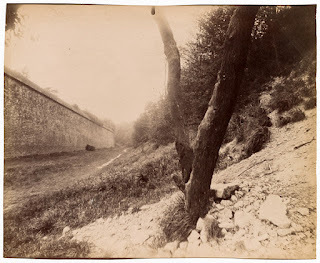
Fortifications of Paris: This album also depicts the Zone, but here concentrating on the undeveloped scrubland directly abutting the walls and defences. This unstructured space was very different to the urban locations Atget normally photographed, which had been densely settled and occupied and redeveloped over hundreds of years.
My earlier comparison between the vehicles album and Ed Ruscha was a little facetious, but here the images genuinely do seem to anticipate the New Topographics trend of the 1970s and 80s, and in particular Lewis Baltz’s projects on San Quentin Point and Candlestick Point from the 1980s, which similarly depict degraded semi-rural environments just outside the city limits. Most of Atget’s images in this album do show aspects of the city defences, but often the fortifications are relegated to the background, and the foreground is instead filled with uncultivated brownfields, which are punctuated with semi-official or desire paths trod out by regular city visitors. These compositions often focus on trees as organising features.
There are also several images of railway tracks and junctions, which exited Paris at several points, or of culverts where polluted water trickled out. Many of the images are quite abstract, for example the one reproduced above, which works as a series of slashing diagonals and v-shapes. In a body of work so obsessed with the accumulated traces of culture and history, these images are quite startlingly different.
Although Nesbit’s book is in many ways an exemplary academic study, it has some issues worth mentioning. As with most humanities writing from the 1990s, you need some tolerance for Foucault, although his The Archaeology of Knowledge is undeniably relevant for a study of a maker of documents for institutional clients. On the whole, this is a well-written book: it's clear and thorough when Nesbit needs to establish a point of fact; it's stylish and sophisticated when advancing an argument. But it does sometimes lapse into academic-ese, and there are a few too many sentences I found impossible to parse even after several readings.
It’s instructive to note how a study like this required a great deal of financial support to enable publication, but even with that support, the image reproduction is ... fine. It's good for this kind of book – actually, it's about the same as my book! – but it's inferior to the Steidl editions we've discussed previously, which use duotone or tritone printing. Here the paper seems to be coated, and the content of the images is reproduced accurately, but the printing is likely black ink only with a single pass through the press, which means the images come out a little flat, with thin blacks and crushed highlights. It does however have a huge number of illustrations, including large-scale reproductions of selected Atget images as figures accompanying the text, along with a wide variety of other visual sources for comparison.
By contrast, the images from the seven albums are presented in appendices, four to a page: that is, much smaller than the actual negatives (and sometimes too small to make out the details mentioned in Nesbit’s commentary). They're also on a different paper stock, with a glossier coating, but the advantage of this is wasted because they're printed darker, which obliterates a lot of the shadow detail. But given how much is included here, and what an enormous labour of compilation and permissions it represents, it’s hard to resent the understandable compromises made in the book's production. Less forgivable is the reluctance to translate key passages from French: sometimes there’s a translation (even if confined to the endnotes), and sometimes there isn’t. People who aren’t fluent in French are interested in reading about Atget too!
This book is now out of print, and second-hand copies are expensive. As an alternative, I’d still recommend the Phaidon 55 on Atget by Gerry Badger, which is much smaller and cheaper second-hand than Atget's Seven Albums – especially since it’s now clear to me how much Badger’s image selection and commentary both draw on Nesbit's work.



